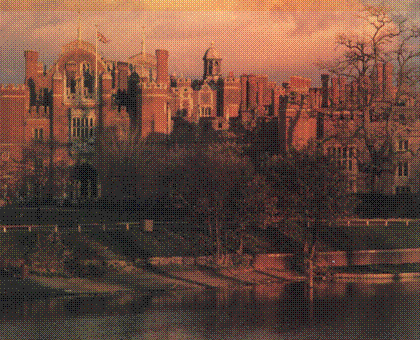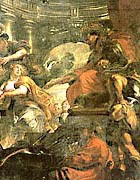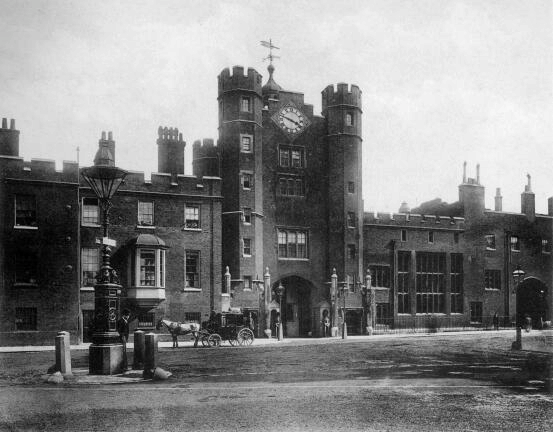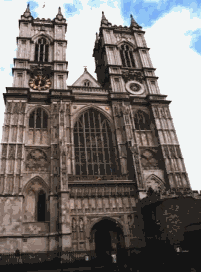
Business Foundation 2
Tu Ngoc Bui (Jade)

It has been the seat of British government and the living quarters of monarchs ... the site of renown political intrigue, and the repository of the Crown Jewels ... It has housed lions, bears, and (to this day) flightless ravens ... not to mention notorious traitors and framed members of court, lords and ministers, clergymen and knights.
The Tower of Londonís history has the different stages of its development from its foundation by William the Conqueror in 1066-7 to its 're-medievalisation' in the 19th century and its fate during the two world wars. Throughout its long history, the Tower has attracted a number of important functions and its role as armoury, royal palace and fortress, prison and place of execution, mint, menagerie and jewel house is explained, as well as its modern role as tourist attraction and home to a thriving community.
The Tower of London has a unique place in the history of the nation. As one of the most important medieval castles in England, a place of imprisonment and execution under the Tudors or a treasure house for the priceless Crown Jewels and the Royal Armouries, the Tower offers an incredible variety of educational possibilities
 |
With its 500 years of royal history Hampton Court Palace has something to offer everyone. Set in sixty acres of world famous gardens the Palace is a living tapestry of history from Henry VIII to George II. From the elegance of the recently restored eighteenth century Privy Garden to the domestic reality of the Tudor Kitchens visitors are taken back through the centuries to experience the Palace as it was when royalty was in residence. |
Hampton Court Palace was the residence of Henry VIII and is the only one of his palaces to survive in anything like its original form. As well as the magnificent State Apartments used by the Tudor court, the complete Tudor Kitchens provide a unique site for investigating life of the period. An unparalleled collection of Henry VIII's tapestries and paintings, such as The Field of Cloth of Gold, make the palace a vital resource for understanding the Tudors.
For almost 200 years, Hampton Court Palace was at the center of court life, politics and national history. Although often identified with Henry VIII, its history was influenced just as much by William III and Queen Mary II in the late 17th century.
 |
In the 19th century Kensington was the birthplace and childhood home of Princess Victoria. She was born in the palace in 1819 and it was here that she learned that she had become Queen. King William III bought the house from the Earl of Nottingham in 1689 and had it remodeled by Sir Christopher Wren. At the time the house was a welcome respite from the unpredictable drains of Whitehall Palace. Several staterooms are open to the public, details. Set in the middle of the graceful Kensington Gardens its is near the fashionable shopping districts of Kensington, Knightsbridge and Chelsea |
| Kensington Palace was once a favoured home of some of Britain's most famous kings and queens and the setting for many great events and dramas in royal history. Originally a private country house, the building was acquired by William III and Mary II in 1689 and was adapted for royal residence by Sir Christopher Wren. For the next 70 years the palace was at the center of the life and government of the kingdom and played host to the courts of William and Mary, Queen Anne, George I and George II. |  |
For education, school groups to Kensington Palace can visit the magnificent State Apartments and the Royal Ceremonial Dress Collection, including regular special exhibitions.
From the early Middle Ages until the middle of the 17th century, the River Thames was the great royal highway of England used by the monarch to travel from palace to palace, from Greenwich in the east to Windsor and beyond to the west. With its riverside location and close proximity to London, Hampton Court and Windsor, Kew and nearby Richmond became convenient and popular country residences for the royal family.
Kew Palace was used by the royal family between 1729 and 1818 and is the last survivor of several important royal residences in the area. Others, including Richmond Lodge and the White House, have long since disappeared but their estates, cultivated and adorned by their owners, form the nucleus of the modern Royal Botanic Gardens.
Currently closed to the public for restoration, a programme of pilot educational initiatives will be available this autumn, in partnership with the Royal Botanic Gardens Kew.
 |
The Banqueting House is the only remaining complete building of Whitehall Palace, the sovereign's principal residence from 1530 until 1698 when it was destroyed by fire. Designed by Inigo Jones for James I (1603-25) and completed in 1622, the Banqueting House was originally built for occasions of state, plays and masques. The magnificent ceiling paintings by Sir Peter Paul Rubens, for which the building is renowned, were commissioned by James I's son, Charles I (1625-49) to celebrate his father's life and wise government and installed by 1636. The Banqueting House later became the scene of Charles I's execution. After the fire that destroyed Whitehall Palace in 1698, the Banqueting House was used as a chapel until 1890. From 1896 until 1962 it was occupied by the Royal United Services Institute and used as a museum. |
The Banqueting House is home of the Tudor and Stuart monarchs from Henry VIII to William III. In the 17th century, there were the building of the Banqueting House by Inigo Jones, the lavish masques put on by the Stuart court and the execution of Charles I in 1649.

Was originally a Hospital for Lepers, founded before 1190 and dedicated to St James' the less. In 1532, the building came into the possession of Henry VIII, who erected in its place, a Royal Palace, said to have been designed by Holbein. Here Queen Mary died in 1558. Charles I slept here the night before his execution.
The Palace was considerably enlarged by Charles I, and after Whitehall was burned down in 1691, it became the chief residence of the English Kings from William III to George IV.
Henry VIII commissioned the construction of St. James' Palace and park between 1532 and 1540. Built on the site of the Hospital of St. James for leper women, this brick palace has since witnessed the births and deaths of many monarchs.
St. James' became the principal royal residence when, in 1702, Queen Anne moved the court here following the 1698 fire that destroyed Whitehall Palace. For 3 centuries it served as a residence for the kings and queens of England. St. James' Palace remains the official residence of the sovereign; however, following Queen Victoria's accession in 1837, Buckingham Palace became the new chief residence for her and all succeeding sovereigns. The English court is still officially known as The Court of St. James. Official and ceremonial court functions continue to be held at St. James'.
The Palace that stands today is mostly the work of architect Christopher Wren (of St. Paul's Cathedral fame.) All that remains from the original structure is a fine 16th C. gateway. The Chapel Royal, preserving a Tudor ceiling dating from 1540, and nearby Queen's Chapel (on Marlborough Road) of 1623/27 is the work of Inigo Jones. The adjoining Clarence House (currently occupied by the Queen Mother) was built by John Nash from 1825 to 1829 by order of the Duke of Clarence- who later ascended to the throne as William IV.
Significant historical events that occurred here include Mary Tudor's signing of the treaty surrendering Calais and her later death, Charles I's confinement prior to his 1649 execution in Whitehall by Oliver Cromwell, Queen Victoria's wedding to her beloved Albert in 1840 and Queen Elizabeth II made her first speech as queen here in 1952.
St. James' Palace now contains the London residences of Charles, The Prince of Wales, and Princess Alexandra and Sir Angus Ogilvy. It houses several state offices as well.
 |
All but two of the British monarchs have been crowned at Westminster Abbey since the coronation of William, Duke of Normandy, on Christmas Day in 1066. The Coronation Chair, made of oak, incorporates the Stone of Scone (on which Scottish kings were once crowned, but which was appropriated by Edward I in 1297 to demonstrate Scotland's subservience to the Crown of England.)
The fan-vaulted Chapel of the Order of Bath, built by Henry VII between 1503 and c. 1512, displays some of the magnificent work of the period and is used as the royal burial place. It contains the tombs of Elizabeth I and Mary, Queen of Scots, among 68 other royals. |
The Chapel of Edward II (the Confessor) and the Sanctuary are within the Ambulatory. The remains of many members of the nobility and church lie within other chapels surrounding the ambulatory. Poet's Corner is the final resting place for famous poets as far back as Chaucer. An unusually decorative altar tomb, dating from 1270 previously located within the Confessor's Chapel now stands near Poet's Corner. This altar tomb was moved to its present location some 650 years ago when Richard II was buried and contains the remains of Henry III's disabled daughter and other royal children. Recent monuments commemorate the Battle of Britain (in the Royal Air Force Chapel) of WWII, the Tomb of the Unknown Soldier of WWI, and the Churchill Stone of 1965.
Edward the Confessor, the last of the old English kings, began the rebuilding of the modest Benedictine abbey church of St. Peter, but died within 10 days of its consecration in 1065. The monks for whom he had built the abbey buried him within its walls. The actual spot in which he was interred is not far from the area where his remains now lie. Only the foundations of the original building comprise the current structure. 600 years of building, re-building and altering have completely changed the abbey's appearance. The general shape of the church is mostly due to Henry III's (1216-72) employment of Master Henry de Reyns to re-begin the Gothic abbey that we see today. The king was, however, unable to complete the work and building operations were subsequently continued into the 14th century by Master of the King's Works Henry Yevele. Yevele followed the original design closely, which is largely responsible for the appearance of the body of the structure to have originated in one architectural period.
Further work, continued by Henry VII (1485-1509) resulted in the lovely Tudor Chapel with its delicate fan vaulting and his tomb was commissioned between 1472 and 1528 by Henry VIII. The impressive northern rosette window was created for Henry VIII and Catherine of Aragon in the 16th century.
The pictures of Kensington Palace came from www.plus44.com.
The picture of Kew Palace came from www.insall-lon.demon.co.uk.
The picture of Westminster Abbey came from www.angelfire.com.